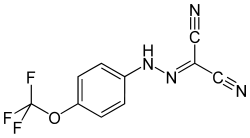Carbonyl cyanide-''p''-trifluoromethoxyphenylhydrazone
 | |
| Names | |
|---|---|
| IUPAC name
2-[[4-(trifluoromethoxy)phenyl]hydrazinylidene]propanedinitrile | |
| Identifiers | |
| 3D model (JSmol) |
|
| ChEBI | |
| ChemSpider | |
| ECHA InfoCard | 100.006.119 |
| MeSH | FCCP |
| PubChem CID |
|
| |
| |
| Properties | |
| C10H5F3N4O | |
| Molar mass | 254.16811 g/mol |
| Except where otherwise noted, data are given for materials in their standard state (at 25 °C [77 °F], 100 kPa). | |
| | |
| Infobox references | |
Carbonyl cyanide-4-(trifluoromethoxy)phenylhydrazone (FCCP) is an ionophore that is a mobile ion carrier. It is referred to as an uncoupling agent because it disrupts ATP synthesis by transporting hydrogen ions through a cell membrane before they can be used to provide the energy for oxidative phosphorylation.[2] It is a nitrile and hydrazone. FCCP was first described in 1962 by Heytler.[3]
See also
References
- ↑ FCCP - Compound Summary, PubChem.
- ↑ MeSH Descriptor Data, MeSH.
- ↑ Heytler, P G (1962). "A new class of uncoupling agents — Carbonyl cyanide phenylhydrazones". Biochemical and Biophysical Research Communications. 7 (4): 272–275. doi:10.1016/0006-291X(62)90189-4.
This article is issued from
Wikipedia.
The text is licensed under Creative Commons - Attribution - Sharealike.
Additional terms may apply for the media files.